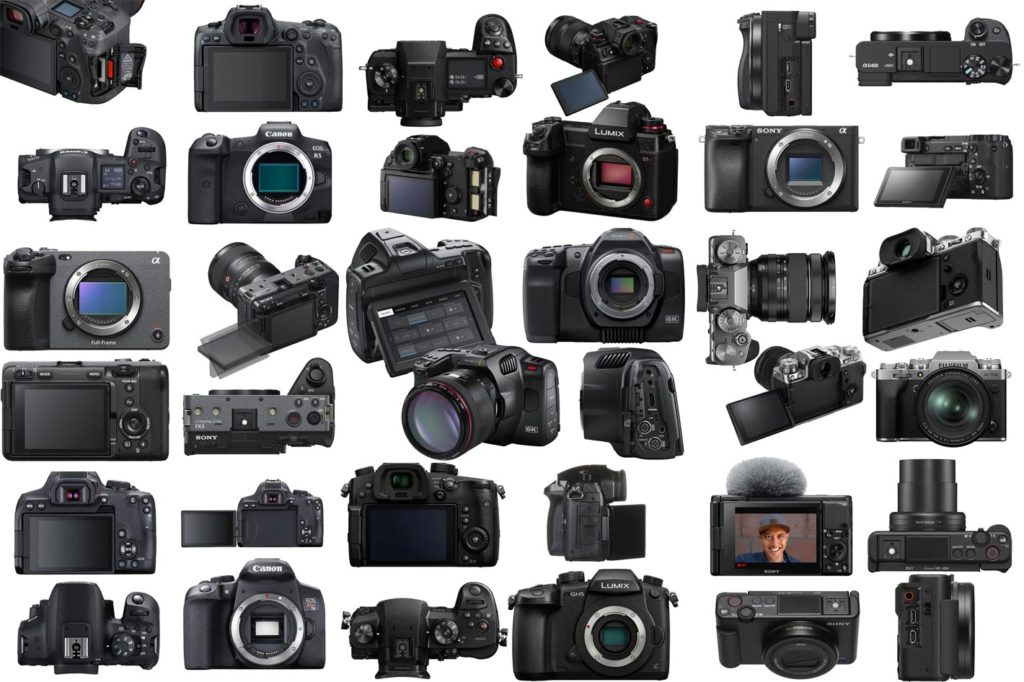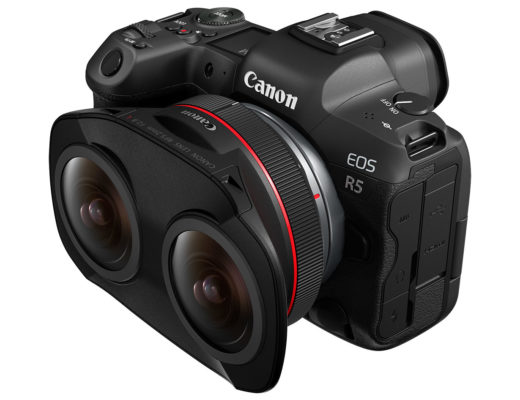 Deciding which camera offers the best bang for the buck is always a difficult process, so we made it easier for you with a series of suggestions for filmmakers and content creators.
Deciding which camera offers the best bang for the buck is always a difficult process, so we made it easier for you with a series of suggestions for filmmakers and content creators.
The “best guides” for anything, be it cameras or software, were, once, divided into groups. With cameras, for example, it made sense, not so long ago, to divide them between DSLRs and mirrorless, as different segments of the market preferred one over the other. Those “guides “do not make much sense any longer, as the frontiers between different types of equipment have, to some extent, been diluted, and many users today may have a mirrorless for some type of work and use a DSLR for other jobs. Or something else…
As mirrorless approached and, according to some, even surpassed DSLRS in terms of their ability to do both video and photography, we’ve seen a shift in not only the models marketed by brands but also the preferences of users, so it makes no sense, any longer, to separate the two segments to create individual guides. It makes more sense, now, to create a global guide that picks cameras from different price points and also includes models adapted to different needs, because that reflects, in my perspective, the real world we live in.
There is no single “best overall camera”, and, as an example, a single user may have a lineup of cameras that fill different needs, from a small action camera, like the GoPro, that can easily be attached to a drone, to a Blackmagic Pocket Cinema 6K camera or Canon EOS C700 adapted to other type of work. He or she may even have a DSLR or mirrorless which excel at some other type of work… and pick a smartphone camera if the occasion asks for a nimble pocketable solution.
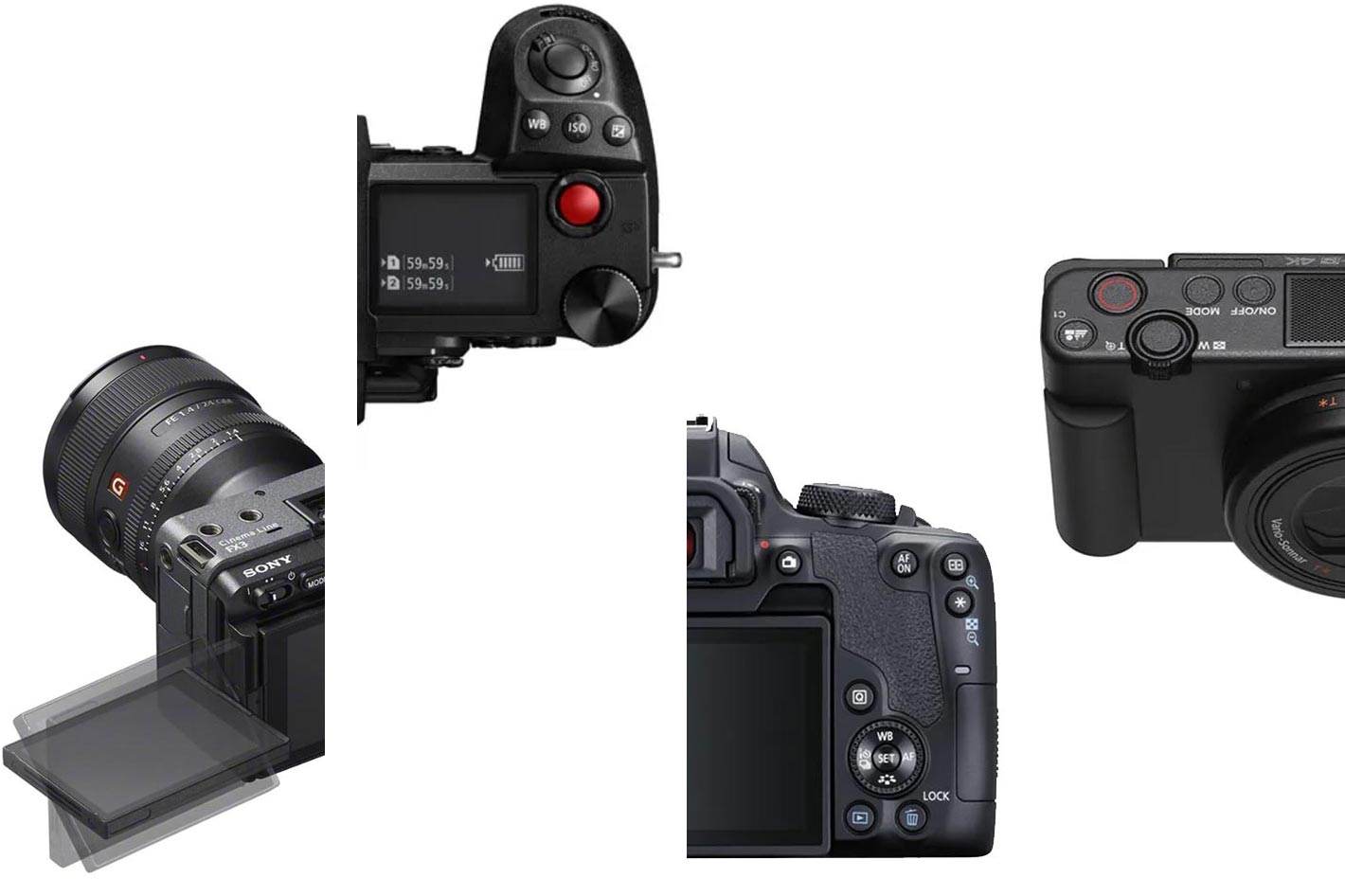 Different cameras, different uses
Different cameras, different uses
Decades ago, photographers would carry at least two bodies, one for black and white and the other with color, either negative or transparency. If you were also capturing video, you would probably have a video camera – or film – of some type with you. Those days are now gone, as modern cameras can capture both stills and moving images, so a single camera may be all you need. Some shooters may just have one camera for all their work, but as technology made it more affordable – and logical – to have different models, many of us amassed a variety of models.
I don’t need to look elsewhere to share an example. On the cabinet behind my desk, I’ve five DSLRs, which is the type of camera I use the most, but I also have two Micro Four Thirds mirrorless models, a small compact camera that can be used underwater, and a Canon Cinema EOS C100. My smartphone is also used, many times just to “take notes” in the field, but it probably should be counted too, as I use it quite often, while scouting locations, to grab images I may want to explore when back home.
So, the term “best camera guide” must be used with care, as it can be deceiving, especially because what’s best for me may not be the best for you. Having written this, I still believe a guide like the one offered here at ProVideo Coalition can help readers to pick the gear that’s best for them. Go through our suggestions as a starting point for an adequate solution for YOUR needs. We may point to the $759 Sony ZV-1 as the ultimate tool for content creators shooting vlogs, but maybe your budget and needs suggest that the $400 Panasonic Lumix DC-ZS70 is a better choice. Only you know what’s right, so use the guide… wisely!
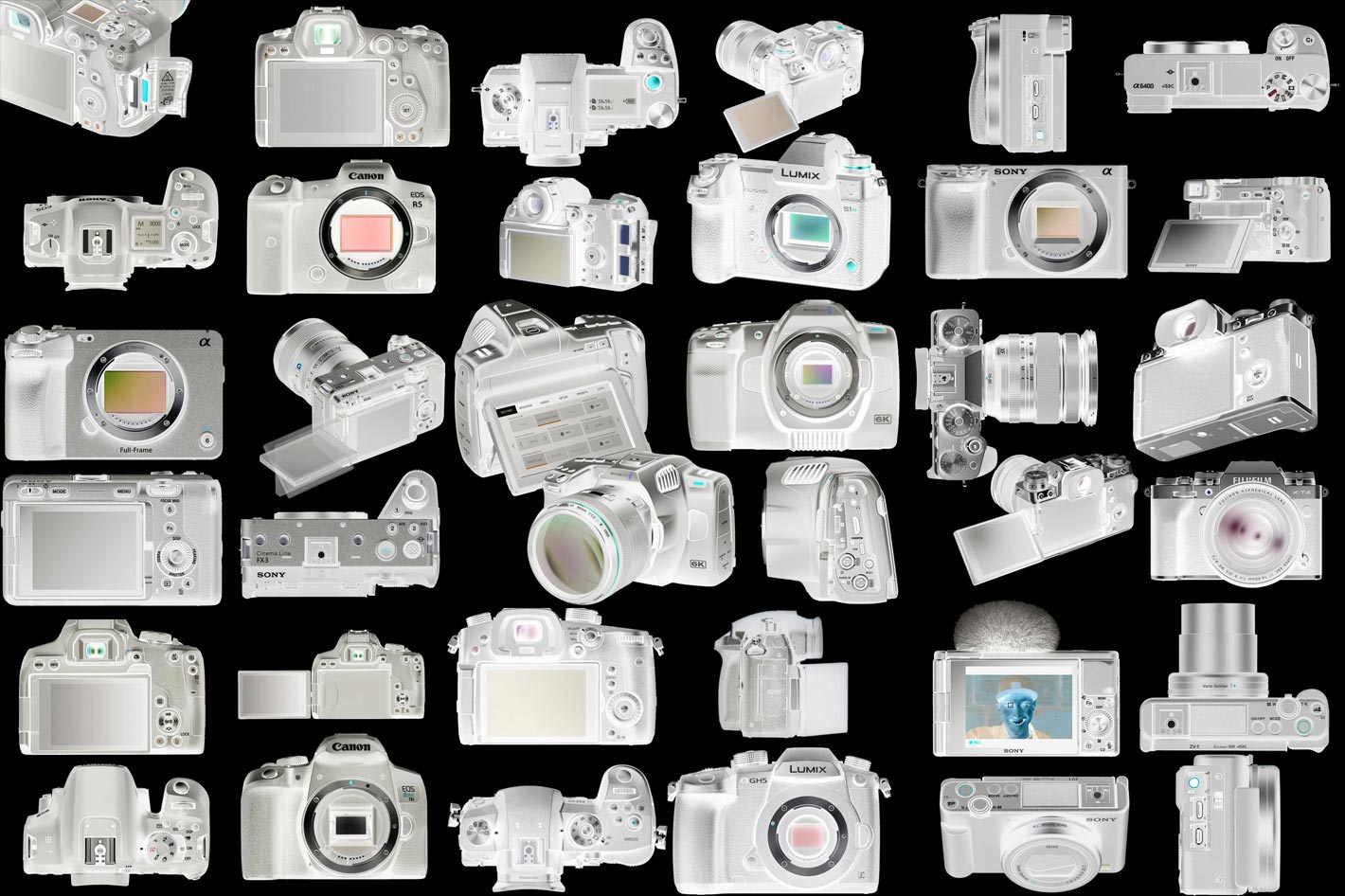 A list of 10 “best” cameras
A list of 10 “best” cameras
One note more before we continue: this guide is not about professional video cameras, camcorders or even absolute video-centric models, but cameras that will offer you both options: moving and still images. Action cameras are also out of the equation because they tend to be very specific in terms of use, as are smartphones, which we’ve also covered here at ProVideo Coalition occasionally. This guide covers DSLRs and Mirrorless models, along with compacts that can also be an ideal compromise for those who need to travel without much gear. It also goes as far as the solutions from Blackmagic Design, that continue to represent a viable option for those who want a more video-centric solution that also does everything else… meaning taking stills!
So, here is ProVideo Coalition’s list of “The Best Cameras to Create YouTube Videos for Filmmakers and Content Creators”. We picked 10, trying to offer a variety of solutions that will keep happy anyone who wants to shoot videos. There is no first or tenth place and the order the models are presented follows an alphabetical order. Use the list as a starting point to make your own choices. Start by understanding what type of video you want to shoot now – and may want to shoot in a near future -, so your investment lasts some time, and go from there.
 Blackmagic Design Pocket Cinema Camera 6K Pro
Blackmagic Design Pocket Cinema Camera 6K Pro
The latest addition to the Pocket Cinema line, the Blackmagic Design Pocket Cinema Camera 6K Pro features a large 6144 x 3456 Super 35 sensor and EF lens mount, allowing you to capture flawless cinematic video. The EF Lens Mount allows you to use larger EF photographic lenses to create cinematic images with shallower depth of field, allowing creative defocused backgrounds and gorgeous bokeh effects.
Whether you’re shooting in bright sunlight or in almost no light at all, the 13 stops of dynamic range with dual native ISO up to 25,600 provide stunning low noise images in all lighting conditions. Additionally, The Pocket Cinema 6K Pro also allows you to shoot up to 60 fps in full resolution or 120 fps windowed.
The Blackmagic Pocket Cinema Camera 6K Pro adds additional pro features such as built in 2, 4 and 6 stop ND filters. It also includes two mini XLR audio inputs and a larger NP-F570 style battery. A large 5″ LCD monitor makes it easy to frame shots and accurately focus and means that you don’t have to carry around an external monitor! The adjustable tilt HDR LCD with a bright 1500 nits is ideal for use in bright sunlight!
Price: $2,495.00 (body only)

Canon EOS R5 Mirrorless Digital 8K Camera
A first for Canon full-frame mirrorless cameras, the EOS R5 can record 8K movies (uncropped, at up to 29.97 fps), all thanks to the high-speed processing capability of the DIGIC X image processor. Despite the initial controversy the R5 is firmly is everyone’s list – as is the R6 for those who only need 4K. While 8K may be overkill for some, the camera also shoots 4K, at speeds up to 119.9fps, in 4:2:2 10-bit (H.265) Canon Log, and Dual Pixel CMOS AF is available in all 8K and 4K modes.
Additional features of the EOS R5 include internally recorded and uncropped 8K RAW recording up to 29.97 fps with Dual Pixel CMOS AF, and HDR-PQ recording (H.265) capability. The EOS R5 is Canon’s first camera to incorporate 5-axis IBIS (In-Body Image Stabilization). This camera not only enhances the ability to shoot still images at slower shutter speeds but it also helps reduce camera shake when shooting movies. Additionally, the EOS R5’s IBIS works in combination with Optical Image Stabilization found in many Canon RF and EF lenses.
With dual card slots for CFexpress and UHS-II SD memory cards, an expansive focus area of approximately 100% horizontal and 100% vertical and a 45MP Full-Frame CMOS Sensor, the Canon EOS R5 delivers unprecedented image stills and cinema like video.
Price: $3,899.00 (body only)
 Canon EOS Rebel T8i DSLR
Canon EOS Rebel T8i DSLR
A good example that you don’t need to break the bank to shoot video is the Canon EOS Rebel T8i DSLR, which represents the ideal introduction to an interchangeable lens camera, if you want a non-mirrorless model. Equipped with a 24.1 Megapixel CMOS (APS-C) sensor, DIGIC 8 image processor and an ISO range of 100-25600 (expandable to 51200), the EOS Rebel T8i offers 4K 24p video capability and vertical video support, along with built-in Wi-Fi and Bluetooth technology, making it easy to share everything you capture.
The 3.0-inch Vari-angle LCD touch screen – a distinctive feature present in Canon’s model since very early – and a range of advanced operating controls make this a good entry-level model able to deliver high-quality performance that kicks your photos and videos up a notch. With a continuous shooting of up to 7 frames per second (up to 7.5 fps during Live View shooting), 45-point all cross-type AF system, EOS iTR AF (Face Detection) during viewfinder shooting and Eye Detection AF during Live View shooting the EOS Rebel T8i DSLR is ideal for vloggers or social media aficionados still in love with DSLRs and looking for an affordable camera.
Price: $749.99
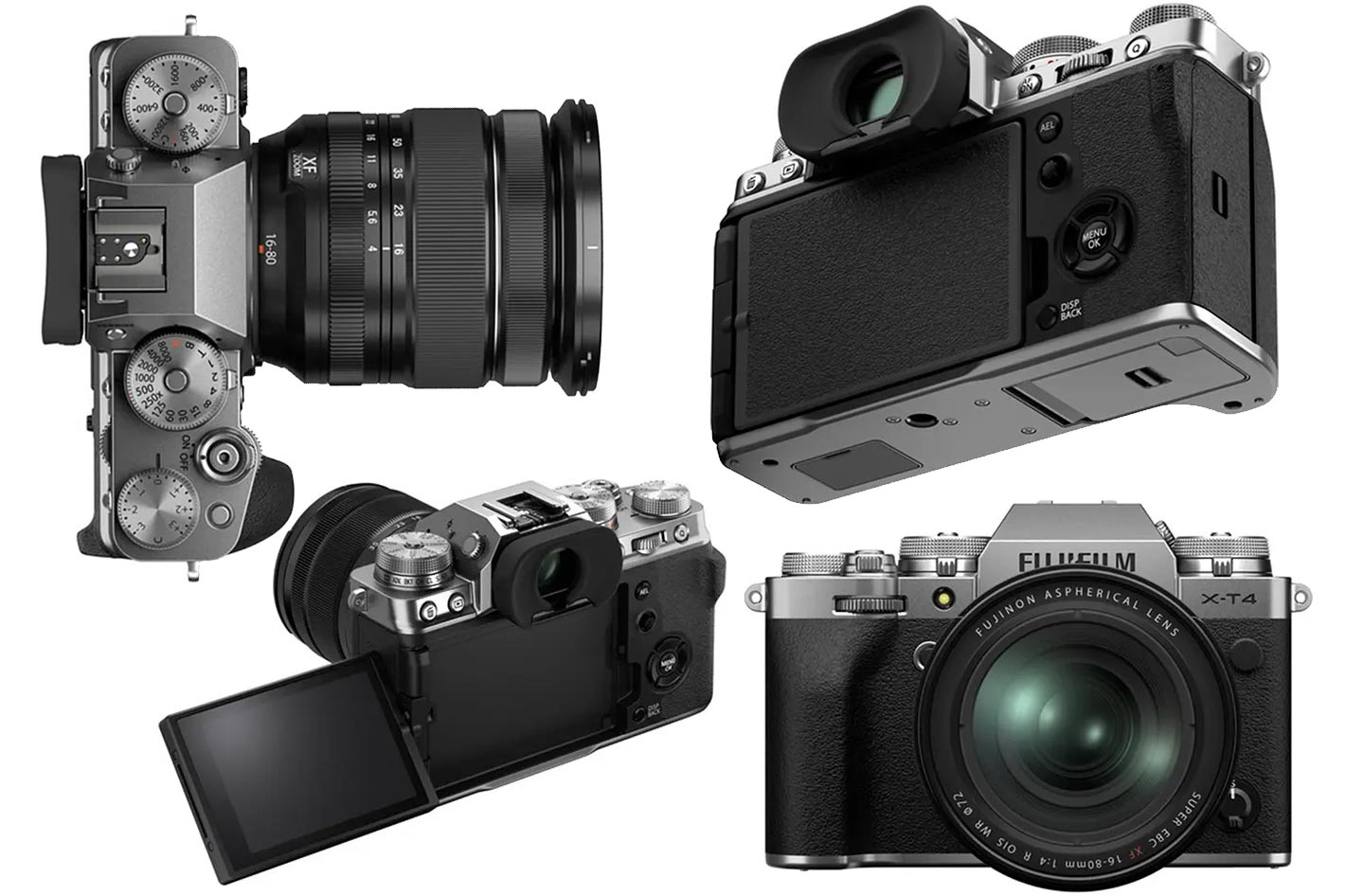
FUJIFILM X-T4 Mirrorless Digital Camera with 16-80mm lens
If the APS-C format is all you want, then the FUJIFILM X-T4 mirrorless digital camera may be all the camera you need. Considered to be one of the most powerful APS-C mirrorless cameras available, this versatile model uses a proven 26.1MP X-Trans CMOS 4 sensor to offer high-resolution recording along with support for DCI/UHD 4K video at 60 fps.
At its heart it’s a photographer’s camera, able to shoot at up to 15 fps with the mechanical shutter, but the X-T4 is surprisingly adapted for video, showing the company’s effort to create solutions for video shooters who use FUJIFILM products. In addition to the Full HD 240 fps high-speed recording which gives you a maximum of 10x slow motion effect, the X-T4 features digital image stabilizer (DIS) and IS (Image Stabilization) Boost mode. By combining these two image stabilization modes with the powerful In-body Image Stabilization, with the X-T4 you can experience a new level of stabilized video shooting without the need of a gimbal or other 3rd party accessories.
The interface was designed with video in mind, so the X-T4 allows seamless transition between shooting stills and movies. The STILL / MOVIE lever on the top panel and video-specific menu, facilitate fuss-free switching between photo and video recording. The addition of the video-only Quick Menu (Q Menu) button has enhanced the camera’s functionality while recording video as well.
Video settings can be changed using the touchscreen panel or the front/rear command dials during video recording. When changing settings like this, the values on the shutter speed dial, ISO dial and aperture ring are ignored, and the camera will keep the exposure settings when switching back from still shooting to video shooting.
Price: $2,199.95 (with a 16-80mm lens that makes this a good starting kit)
 Panasonic Lumix DC-S1H Mirrorless Digital Camera
Panasonic Lumix DC-S1H Mirrorless Digital Camera
The Panasonic Lumix DC-S1H mirrorless digital camera offers a versatile performance for both video and still with a full-frame 24.2MP CMOS sensor and a broad 14-stop dynamic range. It also features sensitivity from ISO 100-51200 and adept processing to realize high color accuracy, responsive recording, and a broad array of video capabilities. Using nearly the full sensor, 3:2-format 6K24p video recording is supported, along with 16:9 5.9K30p and both DCI and UHD 4K60p settings with internal 4:2:2 10-bit sampling.
Inspired by broadcast cameras, the S1H also uses the updated sensor design to provide Dual Native ISO settings that prioritize either low noise or low sensitivity to realize imagery quality with greater color fidelity and reduced noise. Variable Frame Rate (VFR) recording also permits using slow and quick motion effects and High Frame Rate (HFR) settings allow the use of higher frame rates in conjunction with 10-bit sampling. Additionally, V-Log has been pre-installed, and a Hybrid Log Gamma is also available for achieving greater detail when recording, and to benefit color grading during post-production.
Price: $3,999.99 (body only)

Panasonic Lumix DC-GH5 4K Ultra HD Mirrorless Digital Camera
Still a viable option, the Panasonic Lumix DC-GH5 does not need any introduction. The Micro Four Thirds model continues to be an impressive imaging platform for those who need some of the best video and still photography quality available in a single compact camera. The Panasonic Lumix offers a 20.3MP Digital Live MOS sensor able to record UHD 4K video at up to 60 fps, though another excellent spec is the ability to record 4:2:2 10-bit files at resolutions up to DCI and UHD 4K at 24/30 fps. Full HD video at up to 180 fps, 12 fps continuous shooting, and sensitivities up to ISO 25600 are also specifications to note.
A full-size HDMI port is present on the camera for high-quality output at 4:2:2 10-bit in all settings for use with external monitors and recorders. These and other features make the GH5 is an exceptionally capable video camera, designed to be an expandable system, with multiple options available to help improve video recording capabilities. Examples of this are an optional V-Log L upgrade and separately available accessories such as the XLR Microphone Adapter that provides XLR inputs and physical controls through a hot shoe connection. Users can also use standard microphones and headphones via the 3.5mm input and output jacks.
For more advanced users, multiple picture styles are available to provide a more gradable image, such as CINELIKE V and CINELIKE D, as well as an in-camera LUT to make monitoring easier. Also, users will have access to overcranking and undercranking settings which provide speeds up to 2.5x slower in 4K (60 fps) and 7.5x slower in Full HD (180 fps). Also, a 4K Anamorphic mode is available, which will let you record in a proper 4:3 ratio for adjustment in post-production.
Price: $1,997.99 (body only)

Panasonic Lumix DC-ZS70
The Panasonic Lumix DC-ZS70 may not be the dream camera for everybody, and this 2017 model does feel old when compared to most recent models, but you get what you pay for, and this model is included for those who want a “do it all camera” but have a budget that does not reach $400. This compact model features an impressive 30x Leica DC Vario-Elmar zoom lens, which covers a 24-720mm equivalent focal length range, and features UHD 4K video recording at 30p.
Benefitting the long reach of the lens is a powerful 5-axis Hybrid O.I.S. system that compensates for a variety of camera movements for sharper handheld shooting in difficult lighting conditions. This image stabilization system also enables a unique Level Shot function that automatically detects the horizontal line of the recording image and keeps it level during shooting, regardless of camera tilt, helping to achieve greater shooting stability.
If you want a light package that is versatile, with stills and video capabilities for easy handheld shooting, this model with a 20.3MP 1/2.3″ High-Sensitivity Live MOS sensor is a pocket-sized camera that captures all the sights, scenes and emotions of your travels. It may not be the most up to date camera you can own, but for the price, it’s a bargain.
Price: $349.99
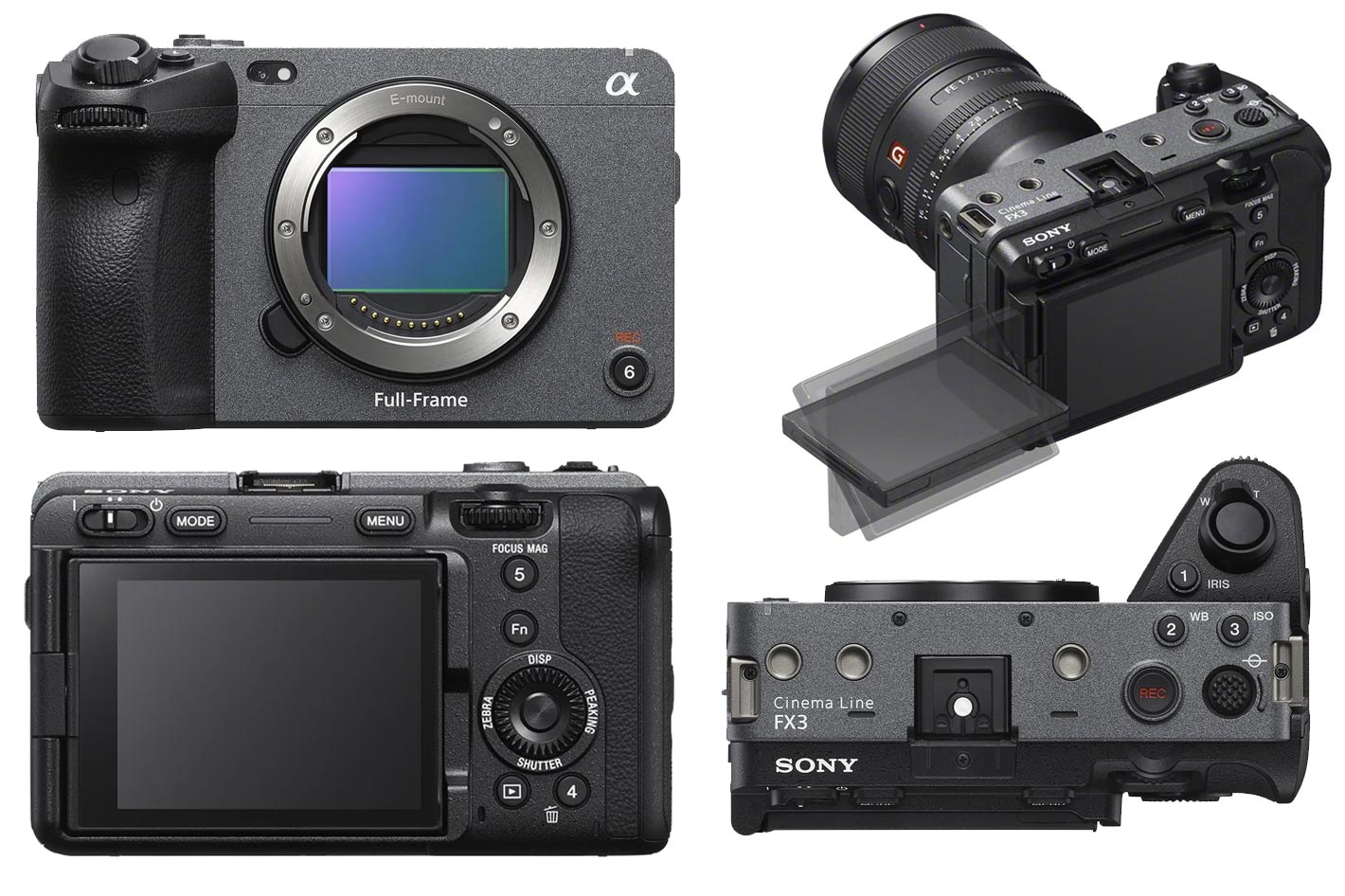
Sony FX3 Full-Frame Cinema Camera
While some will say that the Sony FX3 is just a more expensive Sony A7SIII with a fan and no hump for the electronic viewfinder, the new cinema camera from Sony fills a niche within its FX line, offering high sensitivity and full-frame cinematic expression in an amazingly compact design. The Sony FX3 mixes enhanced mobility for easy solo shooting, alongside pro-operability, making it, according to Sony, the ideal creative tool to capture a cinematic vision anywhere.
Featuring a 35 mm full frame (35.6 x 23.8 mm), Exmor R CMOS sensor, an advanced BIONZ XR image-processing engine and a wide dynamic range, the Sony FX3 can shoot 4K (QFHD) high-framerate 120fps recording with Cinematic color science with S-Cinetone. Sony puts it in a few words: “unlock the world of professional cinema and bring your projects to life with the Sony FX3 Full-Frame Cinema Camera.
Where are some of the highlights of Sony’s FX3:
- 2 megapixel full-frame back-illuminated CMOS Exmor R sensor and BIONZ XR image processing engine
- Ultra-high sensitivity with ISO expandable to 409,600 for very low light conditions and 15+ stops of dynamic range
- S-Cinetone look profile which is inspired by the digital motion picture camera VENICE’s colour science, also used in FX9 and FX6 Cinema Line cameras, and records up to 4K 120p
- Compact and lightweight body design with high operability for hand-held shooting, gimbal and drone-mounted work
- Multi-thread (1/4-20 UNC) body makes it easy to mount accessories
- Detachable XLR handle unit with two of XLR/TRS audio input
- “Active Mode” image stabilisation supports handheld movie shooting
- Fast Hybrid Auto Focus, Touch Tracking (real-time tracking) and Real-time Eye AF, also used in other Alpha cameras
- Uninterrupted 4K 60p recording (Continued) by Effective heat dissipation and built-in cooling fan
Price: $3,898.00 (body only)
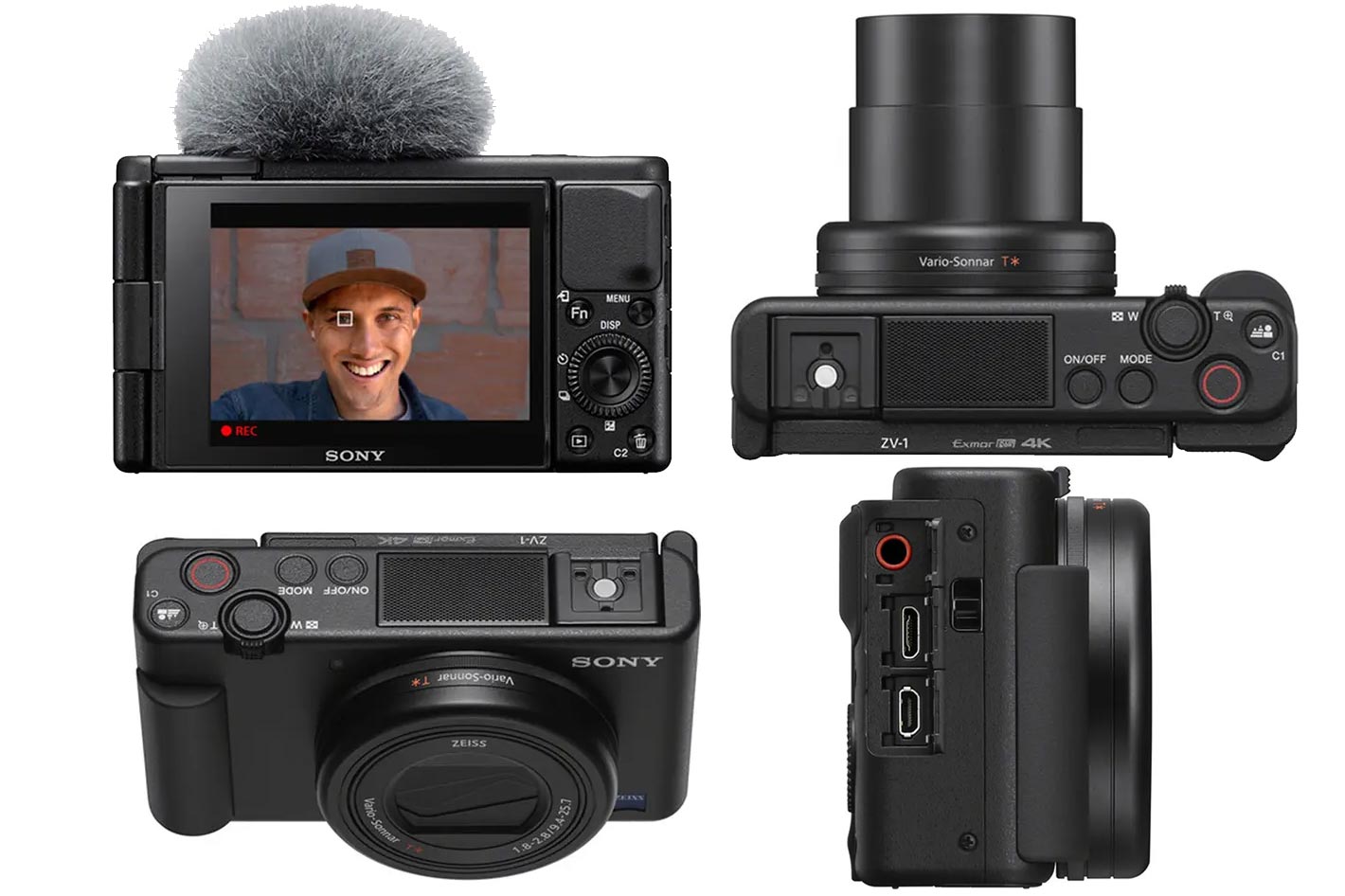
Sony ZV-1 Digital Camera
If a point and shoot is your dream camera, then Sony’s ZV-1 might be all you need. With an integrated ZEISS Vario-Sonnar T* lens covering a useful 24-70mm equivalent range, this compact model is the ultimate tool for content creators shooting vlogs, and other types of online content. The Sony ZV-1 body features a large right-hand grip, a front tally lamp, and a large REC button on the top plate, making it easier for one handed recording.
Capable of capturing 4K UHD Video the ZV-1 is an excellent choice for shooting various types of videos. With a flippable 3.0″ touchscreen that is perfect for front-facing recording, the body also features a directional 3-capsule microphone for enhanced sound recording. Additionally, the ZV-1 also features a Multi Interface Shoe for attaching any essential accessories, like the new ECM-W2BT wireless microphone Sony announced recently.
Able to record UHD 4K video at 30/24 fps, the ZV-1, uses a full pixel readout without binning, to collect about 1.7x the information needed for 4K output. This oversampling helps to increase clarity while reducing the impact of moiré and jaggies. Benefitting sharper recording, an Active SteadyShot mode can be used for recording that prioritizes smoothness when reducing the appearance of camera shake. Fast Hybrid AF is available during movie shooting for ensuring accurate, fast tracking using phase-detection AF points. The camera also offers Sony’s advanced XAVC S format for recording at high bit rates up to 100 Mb/s. In addition to high-resolution internal recording, uncompressed HDMI output also enables the use of an optional external recorder for clean 4K recording with 4:2:2 sampling.
Price: $749.99
 Sony Alpha a6400
Sony Alpha a6400
Are there any Sony cameras good for video that are not compact and cost less than $1,000? Yes, and a good example, even now, is the Sony Alpha a6400 mirrorless digital camera, an APS-C format mirrorless camera that offers many features that are normally reserved for Sony’s full-frame lineup. While there are other models you can explore, the a6400 is well-suited for both photo and video creators, ranging from professionals to vloggers.
Revolving around a 24.2MP Exmor CMOS sensor and BIONZ X image processor, clean image quality is provided with a wide expandable sensitivity range of ISO 100 to 102,400, along with accelerated readout speeds for internal 4K24 and Full HD 1080p120 video recording with full pixel readout. The processor further benefits videographers with the inclusion of an S&Q (Slow & Quick) Motion setting that permits capturing Full HD video at a variety of frame rates ranging from 1-120 fps, plus HLG (Hybrid Log-Gamma), which supports HDR workflows, and both S-Log2 and S-Log3 for color grading flexibility.
The camera has an LCD touchscreen that tilts 180° up and 74° down, UHD 4K movie recording with full pixel readout and no pixel binning, internal recording for time-lapse videos, and more. Increasingly versatile and fully featured in both photo and video realms, the a6400 is a fast and precise imaging tool for multimedia capture.
Price: $898.00 (body only)

Filmtools
Filmmakers go-to destination for pre-production, production & post production equipment!
Shop Now